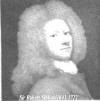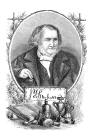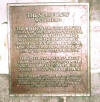Medicine and the
Industrial Revolution . A force for change in 18th and
19th century Scottish medicine.
The establishment of
good medical practice in Scotland is as much part of the
Industrial Revolution as
the ingenuity that went into developing mighty pieces of
machinery. A more widespread medical treatment for the
common man began its existence in the towns and cities
with its development fostered by the demand from poor
people in overcrowded housing, no sanitation and a lack of
awareness among the populace to the cause and spread of
disease. Factors such as these forced consideration of the
causes and contributed to the worldwide reputation of both
Glasgow and Edinburgh as centres of excellence for medical
training.
Medicine and medical aid from the medieval times rested mainly with the monasteries and the Augustinian monks who did much good service with herbal remedies. One such establishment that has recently been subject of archaeological investigation is that of Soutra Aisle, between Edinburgh and the Borders near Duns Law. Founded ca 1160 it was run to assist the poor, travellers, the sick, aged and as a refuge. Funded by the monastic estates it was probably the best endowed medieval hospital in Scotland and received its charter from Malcolm IV in 1164.The `digs` have produced a rich store of data pointing to the use of medicaments from all over the known world, including cloves from East Africa; mixtures of hemlock, black henbane and opium poppies apparently used as sedatives during amputations. Researchers have uncovered evidence that surgery and psychiatric services were supplied and that illegal abortions were made ( bones of very young infants, still born, have been recovered). Instruments such as scalpels point to widespread blood letting; opiates mixed with lard; a form of disinfectant made of myrrh and honey has been found; and ointments for scabies and louse made with arsenic. A mixture of liquorice and coltsfoot plant was given for coughs , bronchitis and catarrh, There was also signs that the diet of patients was of concern with minerals, vitamins and sea salt brought in from further afield. The hospital declined ca 1460 when complaints were made to Rome, and the estates were confiscated and assigned to the Trinity College Hospital in Edinburgh. Before then, in 1336 a prohibition was placed on any friars from practicing medicine because of some scandal ( eg abortions ?); hitherto they had been allowed to practice with a licence granted by the prior. In 1553 the Chapter General of the Black Friars decreed ” We ordain and most strictly prohibit every one of the friars of our Order, under the pain of the graver fault, from following the art of the doctor, physician, or surgeon, and all permits hitherto granted we absolutely annul.”
There had long been the
shamans and those knowledgeable in `country ` or `folk `
medicines. In the Highlands there was the strong Gaelic
tradition of the Beatons and the McConachers as the
traditional physicians. In the Lowlands the educated laird
or minister and his wife might have had some rudimentary
knowledge. The fact was that only the rich had benefit of
medical advice through their employment of the few doctors
that were available in Scotland at the beginning of the
18th century. Moreover it was a time when the dictum of the 16th century essayist, Francis Bacon, held true – ” the weakness and credulity of men is such that they will often prefer a mountebank or witch before a learned physician.”
Until the establishment of a faculty of medicine in 1726 there was little by way of trained doctors available nor was their practice controlled. Thus the streets were available to the peripatetic quacks and their sideshows to amuse, entertain and bemuse the gullible people of Edinburgh. The city in the early 1700s was of some 40,000 souls, closely packed together, rich and poor rubbing shoulders and sharing their diseases. The quacks were often showmen and apart from selling oils, balms, unctions, pills, potions, and liquors of dubious origin, they also staged entertainments such as
tight rope walking, juggling, dances and plays. For a populace working six days a week with the seventh day bound to the kirk, relaxation was little and such shows a great entertainment; and a source for `folk medicines` that sometimes worked. But in the main they were a confidence trick and the medication sold for whatever the quack could get. In one instance a Jon Pontius sold his medicine (1663) for one pound Scots, at a later visit the same was sold for £1.9s.0d; but on a third visit it was only 18 pence. He apparently did a good trade with local physicians who bought his medicines for resale at a profit. In later years the Guild of Surgeons was founded and they took action where possible against the mountebanks and quacks intruding on their trade. On later years the sideshows gave way to better educated persons, perhaps with some actual medical training, who made exaggerated claims for their skills, such as curing `stammering or hesitation of speech`, and disease of the eyes ( including short sightedness). Of the latter, John Taylor MD visited Edinburgh in 1744, calling himself “Chevalier John Taylor, Opthalminator, Pontifical, Imperial, Regal” who had trained at St Thomas` Hospital, London. Part of his presentation was a lecture on “The Eye” given to persons of quality, which is described as a “tissue of bombastic nonsense, but no word of the anatomy or diseases of the eye which he professes to describe and treat”. This charlatan was quick to turn to his advantage the attendance of any doctors or physicians to his lectures, implying that they did so to learn from his expertise. Finally the Royal College of Surgeons and the President and Fellows of the Royal College of Physicians had an exchange of letters which helped drive him away – to Glasgow.
Horace Walpole (1717-1797) wrote of Taylor:
Why Taylor the quack, calls himself Chevalier,
Tis not easy a reason to render,
Unless he would own what his practice makes clear,
That at best he is but a Pretender.
 Sir
Sir
Robert Sibbald (1641 – 1722 ) was instrumental in the
founding of the Edinburgh Botanical Gardens and by growing
medicinal herbs there he produced his “Pharmacopoeia ” in
1699. He was Professor of Medicine at Edinburgh
University in 1685 and also wrote a pamphlet
proposing solutions for poverty. The pamphlet
“Provision for the Poor in Time of Dearth and Scarcity””
listed Scottish herbs and wild plants that were edible and
even advocated eating cat flesh as a means of sustaining
life. He also stands tall in Scottish medical history for
the founding of the Royal College of Physicians where he
was one of the earliest Fellows. He and others saw there
was a need to train the medical man, the physician and the
surgeon; and separate them from the quack and the
apothecary. So it was that with the aid of surgeon, John
Monro and the Lord Provost George Drummond, the Edinburgh
medical faculty was founded in 1726
The first professor was
Alexander Munro (1697 – 1767 ) – who founded the Edinburgh
Royal Infirmary ; followed by his able son Alexander (1733
-1817) and a grandson, the third Alexander Munro (1773 –
1859).
Anatomy can never be far
from the mind in Edinburgh for here were the infamous
Burke and Hare, the body snatchers who eventually murdered
in order to keep up their supply of bodies for anatomical
examination by the likes of Dr Robert Knox (1791 – 1862).
A final irony for William Burke, who was hanged on 28
January 1829, was that he

was convicted on the testimony of his accomplice, Hare,
and his body was also used for anatomical study. One of
the products created to stop body snatching was the
Kingskettle Collar, an iron hoop around the neck and
bolted to the coffin ; another was the ` mort safe` – a
heavy metal cover that dropped over the coffin, which
would be kept there for six weeks or so after which the
body was of no use for dissection in anatomy lessons.
The proper study of the
human body by observation had begun in Italy and brought
to Scotland by Peter Lowe of Glasgow, who was the driving
force in creating the Faculty of Physicians and Surgeons
of Glasgow in 1599. The Hunter brothers , William ( 1718
-1783) and John (1728-1793 ) were anatomists born in East
Kilbride, who made their names in London. John Hunter
worked at St. George’s Hospital in London at a time when
very little was known about the workings of the human
body. His own work in dissection, examining dead bodies to
understand how they function, made him the founder of
pathological anatomy. William was a pioneer in obstetrics.
Both were collectors of sample parts of the human body and
were the founders of the Hunterian Collection at the
University of Glasgow. As early as 1678 the surgeons in Edinburgh were pressing for the provision of bodies, having an agreement that they would receive a malefactors body once a year. At this time it was common practice in Paris and Leyden to provide bodies of those who died in hospital, for disection.
Inherent in the teaching
of anatomy was the development of surgical skills with
eminent surgeons such as Robert Liston (1794 – 1847 ) from
Ecclesmachan, West Lothian, whose speed in the operating
theatre was legendary. Liston was responsible for
publicising the early use of ether as an anesthetic when
he removed the right leg of a Frederick Churchill, a
Harley Street butler, on 21 December 1846. This was widely
publicised although the first doctor to use ether in
Europe was in fact Dr William Scott (photo right), a surgeon at the
was in fact Dr William Scott (photo right), a surgeon at the
Dumfries and Galloway Royal Infirmary two days earlier on
19 December
1846. To the operating theatre also came London born
Joseph Lister (1827 – 1912) who became surgeon at Glasgow
Royal Infirmary in 1860 and introduced the use of
antiseptic carbolic acid sprays to control infection to
wounds. While William MacEwan (1848 – 1924 ) developed
aseptic surgery which involved sterilizing equipment and
bandages and ` scrubbing up` of the staff involved in the
operation.
Experience of anatomy
before the creation of proper schools usually came from
the battlefield and the often crude amputations that it
called for. Military service abroad also played a part in
the use of quinine for treatment of malaria which was at
one time rife in Scotland, as discovered by Army surgeon
George Cleghorn (1716 – 1794). In later years Sir Patrick
Manson ( 1844 – 1922 ) was to make the link of malaria and
the mosquito. While James Lind ( 1716 – 1794) a Naval
physician, identified that a diet of fresh vegetables or
including citrus fruits was a cure for scurvy.
I n
n
Glasgow Joseph Black ( 1728 – 1799 ) was professor of
anatomy from 1756 and then of chemistry in Edinburgh from
1766. He discovered carbon dioxide and the concepts of
latent and specific heat. In doing this he used the
thermometer developed by George Martine ( 1702 – 1741) and
Alexander Wilson ( 1714 – 1786 ) both of St Andrews. Most
important of Joseph Black`s work was that he brought the
concept of scientific measurement to medicine and the use
of the fine chemical weighing scales and the thermometer.
Other, better known,
discoveries followed in the 1800s with James Braid ( 1795
Braid ( 1795
– 1860 ) discovering hypnosis. Sir James Young Simpson
(1811 – 1870) (image right) discovered chloroform as an anaesthetic and
although subject of some criticism by the clergy he
championed its use. Acceptance by all was given a great
boost when Queen Victoria used chloroform during child
birth.
Alexander Wood (1725 – 1800) discovered the hypodermic
syringe and, of course, there was Alexander Fleming`s
(1881-1955) discovery of penicillin. Less well known but
important was the work of John Hughes Bennett ( 1812 –
1875 ) who was a pioneer pathologist and discovered
Leukaemia. Other Scottish doctors of note include, Robert
Philip (1857-1939), tuberculosis expert, and John James
Rickard Macleod, who was born in 1876, a leader in the
field of diabetes research, heading the group that
discovered insulin.
Scotland was also to the
fore in providing treatment for mental disabilities. The
Crichton Institution for Lunatics was funded by the
bequest of James Crichton of Friars Carse, Dumfries. In
the following year it became the Crichton Royal Hospital
by Act of Parliament. The advertisement for the hospital`s
opening in June 1839 includes this statement, indicating
policies that were far ahead of their time:
” The great
principles upon which this Institution will be conducted
are justice, benevolence, and occupation; and by the
application of these the Patients, in so far as is
consistent with their condition, will be induced to regard
the Asylum as a home, and those to whose care they are
confided as friends and companions. “
Its innovative treatment
under Dr William Browne included patients taking part in
amateur dramatics and producing their own magazine that
was widely circulated. – all the therapy now promoted 150
years later. And in 1854, Dr Browne initiated a course of
thirty nursing lectures – six years before Florence
Nightingale grabbed the headlines. The hospital thrived
and expanded to take in some 1000 acres of land with farm
buildings, electricity generators, a church, and houses to
accommodate various categories of patients.
The hospital became a
showpiece and a leading establishment for treatment of
mental illness in all Europe. In the post war years the

hospital was to the fore with physical treatments such as
Electric Convulsive Therapy (ECT), Insulin Coma Therapy
and pre frontal Leucotomy. With new drugs from about 1950
the hospital achieved recovery rates that hitherto were
unimaginable and was regarded internationally as a
training and treatment centre. Easterbrook House is now
the location for a medical museum.
Among the early leaders
in health education was Dr
William Buchan ( 1729 – 1805) who practiced medicine
in Edinburgh for 12 years and produced many papers on
health education. His book ” Domestic Medicine ” was the
first book to give simple, pragmatic advice on health
issues – particularly personal hygiene, based on ` modern
` medicine. An annex to his work included a pharmacopoeia
and advice on treatment of some common diseases. In this
work of educating and helping the common man there was the
indefatigable Andrew Duncan ( 1744 – 1828 ) who set up the
Edinburgh Public Dispensary in 1776.
The need to tackle the
environmental problems, the overcrowding ; lack of clean
water, negligible sanitation crystallised in Glasgow which
by the end of the 19th century was at the centre of the
most heavily industrialised area in the world. Into this
arena came James Russell (1837 – 1904 ) as Medical Officer
of Health. He worked with other specialists and got to
know the problems of the workers – those in jute and flax
manufacture suffered from dust inhalation as did miners
and quarry workers; ironworkers suffered from excessive
heat; and lead was poisonous. He took an interest in food,
its storage and preparation and brought in meat
inspectors. A major improvement was brought about by the
employment of Isambard Kingdom Brunel and Robert
Stephenson to report on the means of delivering fresh
water to the city. This was finally achieved in 1859 by
bringing 50,000 gallons of water a day the 34 miles from
the Trossachs. In 1878 the first `wash house` was
established that allowed washing of clothes and linen,
followed by public bath houses and a swimming pool.
 In
In
Edinburgh too, the need for fresh water had been addressed
as early as 1675 by supply from springs in the Pentland
Hills and using the force of gravity to deliver it from a
reservoir atop the Castle Hill to water cisterns around
the city. This supply was little enough and over time some
13 reservoirs were created to fill the city`s needs. Sir
Henry Duncan Littlejohn ( 1826 – 1914.) was another
enlightened Medical Officer of Health who oversaw these
changes to water supply and sanitation. He also brought in
the requirement to notify infectious diseases so as to
prevent epidemics, such as typhus, ripping through the
overcrowded tenements.
Through the Industrial
Revolution and into the 20th century, many thousands of
Scots died from diseases such as smallpox, typhus, cholera
and even malaria. Many men women and children were
crippled in the course of their often dangerous work and
required life saving surgery, or suffered from disease
that thrived in the appalling living conditions of their
day. The contribution made by the doctors and surgeons
undoubtedly made their life longer but also brought
increasing pressure to bear on the private landlords who
owned the slums, and thereby contributed to the social
engineering and improvements for the common good.